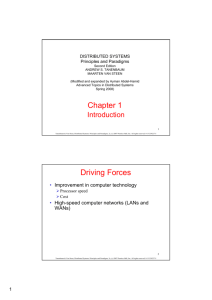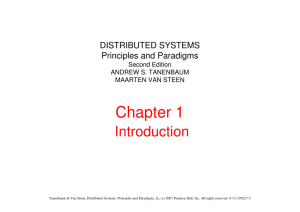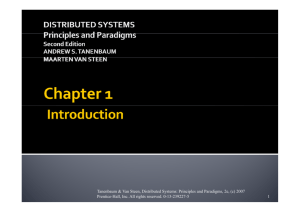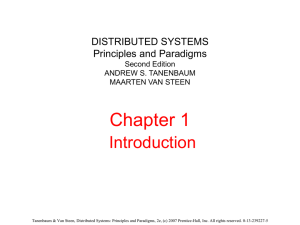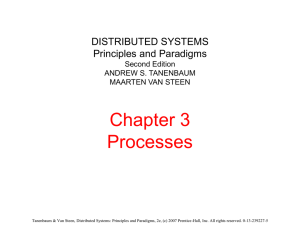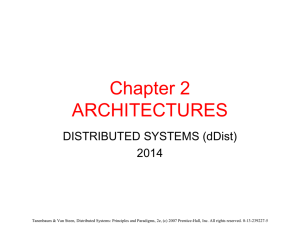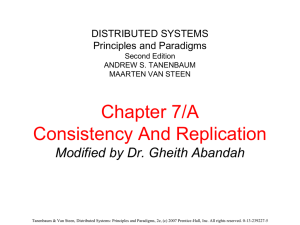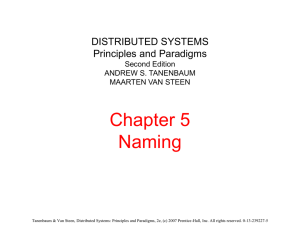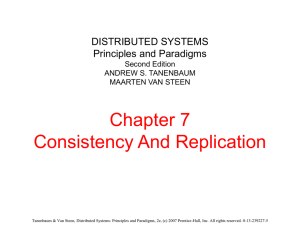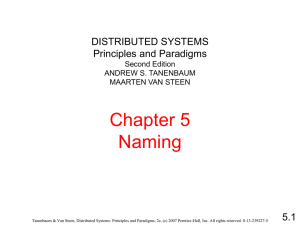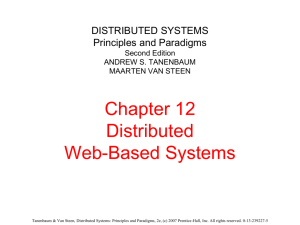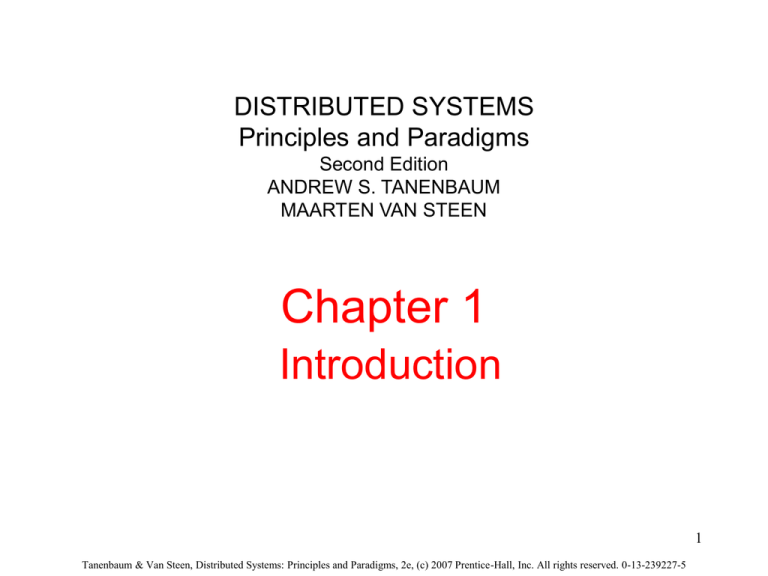
DISTRIBUTED SYSTEMS
Principles and Paradigms
Second Edition
ANDREW S. TANENBAUM
MAARTEN VAN STEEN
Chapter 1
Introduction
1
Tanenbaum & Van Steen, Distributed Systems: Principles and Paradigms, 2e, (c) 2007 Prentice-Hall, Inc. All rights reserved. 0-13-239227-5
Definition of a Distributed System (1)
A distributed system is:
A collection of independent
computers that appears to its
users as a single coherent
system.
2
Tanenbaum & Van Steen, Distributed Systems: Principles and Paradigms, 2e, (c) 2007 Prentice-Hall, Inc. All rights reserved. 0-13-239227-5
Definition of a Distributed System (2)
Figure 1-1. A distributed system organized as middleware. The
middleware layer extends over multiple machines, and offers
each application the same interface.
3
Tanenbaum & Van Steen, Distributed Systems: Principles and Paradigms, 2e, (c) 2007 Prentice-Hall, Inc. All rights reserved. 0-13-239227-5
Transparency in a Distributed System
Figure 1-2. Different forms of transparency in a
distributed system (ISO, 1995).
4
Tanenbaum & Van Steen, Distributed Systems: Principles and Paradigms, 2e, (c) 2007 Prentice-Hall, Inc. All rights reserved. 0-13-239227-5
Scalability Problems
Figure 1-3. Examples of scalability limitations.
5
Tanenbaum & Van Steen, Distributed Systems: Principles and Paradigms, 2e, (c) 2007 Prentice-Hall, Inc. All rights reserved. 0-13-239227-5
Scalability Problems
Scalability can be measure along 3 dimensions:
• Size scalable: easily add more users &
recourses to the system
• Geographically scalable: users & resources may
lie far apart
• Administratively scalable: it can still be easy to
manage even if it spans independent
administrative organizations
6
Tanenbaum & Van Steen, Distributed Systems: Principles and Paradigms, 2e, (c) 2007 Prentice-Hall, Inc. All rights reserved. 0-13-239227-5
Scalability Problems
Characteristics of decentralized algorithms:
• No machine has complete information about the
system state.
• Machines make decisions based only on local
information.
• Failure of one machine does not ruin the
algorithm.
• There is no implicit assumption that a global
clock exists.
7
Tanenbaum & Van Steen, Distributed Systems: Principles and Paradigms, 2e, (c) 2007 Prentice-Hall, Inc. All rights reserved. 0-13-239227-5
Scaling Techniques (1)
Figure 1-4. The difference between letting (a) a server
or (b) a client check forms as they are being filled.
8
Tanenbaum & Van Steen, Distributed Systems: Principles and Paradigms, 2e, (c) 2007 Prentice-Hall, Inc. All rights reserved. 0-13-239227-5
Scaling Techniques (2)
Figure 1-5. An example of dividing the DNS
name space into zones.
Tanenbaum & Van Steen, Distributed Systems: Principles and Paradigms, 2e, (c) 2007 Prentice-Hall, Inc. All rights reserved. 0-13-239227-5
9
Pitfalls when Developing
Distributed Systems
False assumptions made by first time developer:
• The network is reliable.
• The network is secure.
• The network is homogeneous.
• The topology does not change.
• Latency is zero.
• Bandwidth is infinite.
• Transport cost is zero.
• There is one administrator.
10
Tanenbaum & Van Steen, Distributed Systems: Principles and Paradigms, 2e, (c) 2007 Prentice-Hall, Inc. All rights reserved. 0-13-239227-5
Types of Distributed Systems:
1.
Distributed Computing Systems
–
–
2.
Cluster Computing Systems
Grid Computing Systems
Distributed Information Systems
–
–
3.
Transaction Processing Systems
Enterprise Application Integration (Exchange info via RPC or RMI)
Distributed Pervasive Systems (usually small, batterypowered systems, Mobile & wireless)
–
–
–
Home Systems (e.g. Smart phones, PDAs)
Electronic Health care systems (Heart monitors, BAN: Body Area
Networks)
Sensor Networks (distributed Databases connected wirelessly)
11
Tanenbaum & Van Steen, Distributed Systems: Principles and Paradigms, 2e, (c) 2007 Prentice-Hall, Inc. All rights reserved. 0-13-239227-5
Cluster Computing Systems
–
–
–
Hooking up a collection of simple computers via
high-speed networks to build a supercomputing
environment
Mostly homogenous
Example: server clusters at Banks, Brokerages, etc.
12
Tanenbaum & Van Steen, Distributed Systems: Principles and Paradigms, 2e, (c) 2007 Prentice-Hall, Inc. All rights reserved. 0-13-239227-5
Cluster Computing Systems
Figure 1-6. An example of a cluster computing system.
13
Tanenbaum & Van Steen, Distributed Systems: Principles and Paradigms, 2e, (c) 2007 Prentice-Hall, Inc. All rights reserved. 0-13-239227-5
Grid Computing Systems
–
–
–
In contrast to cluster computing, grid computing
systems have a high degree of heterogeneity, no
assumption are made concerning hardware, OS,
Networks, Security, …
Users and recourses from different organizations are
brought together to allow collaboration (i.e. a V.O.
= Virtual Organization)
Members belonging to the same V.O. have access
rights to a common set of recourses (e.g. Police,
FBI, and some local agencies may form a
computing grid)
14
Tanenbaum & Van Steen, Distributed Systems: Principles and Paradigms, 2e, (c) 2007 Prentice-Hall, Inc. All rights reserved. 0-13-239227-5
Grid Computing Systems
Applications operate
within a virtual
organization and make
use of grid computing
environment
Grid
Middleware
Figure 1-7. A layered architecture for grid computing systems.
15
Tanenbaum & Van Steen, Distributed Systems: Principles and Paradigms, 2e, (c) 2007 Prentice-Hall, Inc. All rights reserved. 0-13-239227-5
Grid Computing Layers:
1. Collective layer: access to multiple resources and
typically consists of services for resource discovery,
allocation and scheduling.
2. Connectivity layer: transfer data between resources
or access a resource from a remote location
3. Resource layer: managing a single recourse such as
creating a process or reading data
4. Fabric layer: provides interface to local resources at
a specific site within a V.O.
16
Tanenbaum & Van Steen, Distributed Systems: Principles and Paradigms, 2e, (c) 2007 Prentice-Hall, Inc. All rights reserved. 0-13-239227-5
Transaction Processing Systems (1)
Figure 1-8. Example primitives for transactions.
17
Tanenbaum & Van Steen, Distributed Systems: Principles and Paradigms, 2e, (c) 2007 Prentice-Hall, Inc. All rights reserved. 0-13-239227-5
Transaction Processing Systems (2)
Characteristic properties of transactions:
• Atomic: To the outside world, the transaction
happens indivisibly.
• Consistent: The transaction does not violate
system invariants.
• Isolated: Concurrent transactions do not
interfere with each other.
• Durable: Once a transaction commits, the
changes are permanent.
18
Tanenbaum & Van Steen, Distributed Systems: Principles and Paradigms, 2e, (c) 2007 Prentice-Hall, Inc. All rights reserved. 0-13-239227-5
Transaction Processing Systems (3)
Figure 1-9. A nested transaction.
19
Tanenbaum & Van Steen, Distributed Systems: Principles and Paradigms, 2e, (c) 2007 Prentice-Hall, Inc. All rights reserved. 0-13-239227-5
Transaction Processing Systems (4)
Figure 1-10. The role of a TP monitor in distributed systems.
20
Tanenbaum & Van Steen, Distributed Systems: Principles and Paradigms, 2e, (c) 2007 Prentice-Hall, Inc. All rights reserved. 0-13-239227-5
Enterprise Application Integration
Figure 1-11. Middleware as a communication facilitator in
enterprise application integration.
21
Tanenbaum & Van Steen, Distributed Systems: Principles and Paradigms, 2e, (c) 2007 Prentice-Hall, Inc. All rights reserved. 0-13-239227-5
Enterprise Application Integration
Various middleware packages and
communication protocols are used in
support of Enterprise applications such as:
•
•
•
•
CORBA (Common Object Request Broker Architecture)
DCOM (Distributed Component Object Management)
RPC (Remote Procedure Call)
RMI (Remote Method Invocation)
22
Tanenbaum & Van Steen, Distributed Systems: Principles and Paradigms, 2e, (c) 2007 Prentice-Hall, Inc. All rights reserved. 0-13-239227-5
Distributed Pervasive Systems
Requirements for pervasive systems:
•
•
•
Embrace contextual changes (i.e. I was a
phone now I am a web access device. A
device must continuously be aware of the
fact that its environment may change)
Encourage ad hoc composition (used
differently by different users, e.g. PDA)
Recognize sharing as the default (easily
read, store, manage, and share info)
23
Tanenbaum & Van Steen, Distributed Systems: Principles and Paradigms, 2e, (c) 2007 Prentice-Hall, Inc. All rights reserved. 0-13-239227-5
Electronic Health Care Systems (1)
Questions to be addressed for health care systems:
• Where and how should monitored data be
stored?
• How can we prevent loss of crucial data?
• What infrastructure is needed to generate and
propagate alerts?
• How can physicians provide online feedback?
• How can extreme robustness of the monitoring
system be realized?
• What are the security issues and how can the
proper policies be enforced?
24
Tanenbaum & Van Steen, Distributed Systems: Principles and Paradigms, 2e, (c) 2007 Prentice-Hall, Inc. All rights reserved. 0-13-239227-5
Electronic Health Care Systems (2)
Figure 1-12. Monitoring a person in a pervasive electronic health
care system, using (a) a local hub or
(b) a continuous wireless connection.
25
Tanenbaum & Van Steen, Distributed Systems: Principles and Paradigms, 2e, (c) 2007 Prentice-Hall, Inc. All rights reserved. 0-13-239227-5
Sensor Networks (1)
Questions concerning sensor networks:
• How do we (dynamically) set up an
efficient tree in a sensor network?
• How does aggregation of results take
place? Can it be controlled?
• What happens when network links fail?
26
Tanenbaum & Van Steen, Distributed Systems: Principles and Paradigms, 2e, (c) 2007 Prentice-Hall, Inc. All rights reserved. 0-13-239227-5
Sensor Networks (2)
Figure 1-13. Organizing a sensor network database, while storing
and processing data (a) only at the operator’s site or …
27
Tanenbaum & Van Steen, Distributed Systems: Principles and Paradigms, 2e, (c) 2007 Prentice-Hall, Inc. All rights reserved. 0-13-239227-5
Sensor Networks (3)
Figure 1-13. Organizing a sensor network database, while storing
and processing data … or (b) only at the sensors.
28
Tanenbaum & Van Steen, Distributed Systems: Principles and Paradigms, 2e, (c) 2007 Prentice-Hall, Inc. All rights reserved. 0-13-239227-5

